This month’s homegrown featured our friend Andy Kurtts, former AIGA Raleigh board member, and current president of the AIGA Triad NC chapter (which he lead the founding of). Andy is as, he described, a designer, artist, father, husband (married to his high school sweetheart), animal-lover, observer, and wannabe (not in the poser way, but as someone who dabbles in things that interest him). But for his day job, he is the Design Manager for the Fresh Market, where he and his team are tasked with creating the packaging for The Fresh Market’s private label brand among other things. The team is always looking for ways to incorporate handmade elements into their designs and it has become part of the brand. What they come up with are packages that practically jump of the shelves into your shopping cart.
Andy has been an artist all his life, a talent nurtured through art classes throughout junior and high school. So he has been creating art most of his life, but where he first felt connected to the process of creating was in a photography class where he learned how to develop film and make prints from them. Having taken darkroom classes myself, I can relate to taking enjoyment from the process and the connection that it creates with what you make.
That connection to the crafting of something is what attracts us to things that are handmade. We can see the artist’s hand in the final product, and envision a human creating it. Something like a letterpress hangtag or textured background that looks so real, you want to reach out and touch it. It’s warm and inviting, and evokes a sense of nostalgia—the feeling of connecting to artists of the past. It can lend a sense of authenticity to a design that you just can’t create digitally.
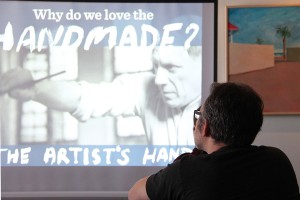
While you could craft the packaging entirely by hand, producing for the masses just isn’t practical. But, hey for a one-off like a gift for your mom or a friend, why not create a custom package by hand. (I do this a lot and it’s fun, and there’s just something so satisfying in making something by hand. I quite often make the gifts themselves, too.)
While the sky’s the limit as to how to add that handmade feel to your design, you don’t need to go all out handmade to achieve it. Create a texture by hand and bring it into the digital realm to use as a background or use as a fill for shapes in the design.
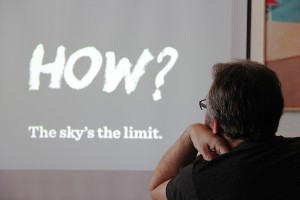
Don’t try to recreate a handmade look on the computer, get your hands dirty and make it yourself. There are just some things you simply can’t produce the desired result digitally, it needs to be done by hand to be authentic because the organic process involved in creating in creating it is what creates the effect. A great example that Andy shared was the Italian Chocolate Bar packaging he and his team created, which was the first project he talked about.
Since we were all here to get ideas for how to get our hands dirty designing by hand, Andy shared a few projects where the handmade element really helped packages pop off the shelf.
First up was The Fresh Market’s line of premium Italian Chocolate Bars. The Design team was inspired by art from Renaissance era. The characters used in the packaging were hand drawn in a style inspired by the Commedia dell’Arte, then scanned and colored. By scanning and not tracing in Illustrator, they retain their rough edges and charm. And that beautiful marbled pattern used in the packaging, yup, that has handmade, too. There’s just no way to recreate that look digitally. The swirls and blending of the colors are organic to the process of marbleizing the paper. The results are just beautiful and authentic because they were handmade.
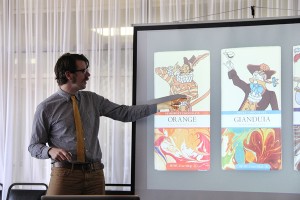
Next Andy shared with us process behind the design for The Fresh Market’s line of Jam’s and Jellies. For this project, the team again strayed from their computers, this time to create watercolor illustrations that expressed the organic handmade qualities of the jams and jellies. After dozens of lettering sketches to come up with just the right hand drawn typography, a random phone message from a co-worker turned out to be just the look they were after. They had her write out the alphabet and scanned in the letters to use to create the custom lettering on the packaging.
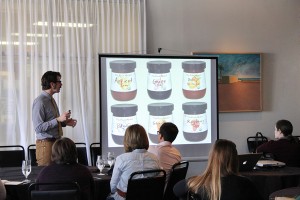
In the next project, the challenge was how to make a boring foil-lined packet look homemade. The product was The Fresh Market’s line of all natural dry salad dressing mixes. What they came up with was a craft project you may have done as a kid, potato stamping. The results were not great, except for the carrot shape. That one came out great and inspired the rest of the graphics. They brought the characteristics of the carrot shape into the other shapes which were created in Illustrator. To add interest to the background of the stamped icons, they used a textured background, distressed background that adds far more interest than a plain white background would.
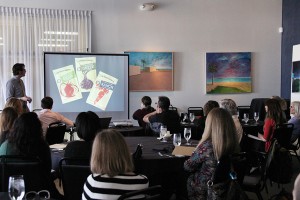
The next project was another boring substrate challenge, a canister for Old Fashioned Oats. There was not much to work with to make it look handmade. Their solution was to focus on the background texture. They made ombre dyed fabrics then photographed the product on them. Sure, they could have faked it all in Photoshop, but why fake it when you can make it. It really does look better and it’s way more fun.
Another mundane substrate was the challenge in the next project Andy shared ( I see a trend here). The team was limited by the print process which involves being printed on a drum. Their inspiration for this project was probably one of your favorite books as a kit, The Hungry Caterpillar. The cut paper illustration style of the book was what they aimed to create themselves. They painted big swatches of paper, let them dry, and then scanned them. They really liked the texture created when parts of the paper wrinkled as it dried. They used the scans as fills for the fruit shapes they created in Illustrator. The handmade quality of the paper remains intact and adds a lot of interest to the design.
One of Andy’s favorite project actually wasn’t handmade, but it was inspired by a handmade process—letterpress. Initially the creative brief for one of The Fresh Market’s private label brands, a line of thin crust pizzas, was to make the packaging look like all the other pizzas on the shelves. The design team asked ‘why would a customer buy this brand new line over the established competitors in the freezer case if it blended in with the rest?’ While doing creative research for inspiration as to how to incorporate a handmade look to the pizza packaging, they became inspired by a collection of wood type letterpress typefaces and Hatch Show Print posters. The line of pizzas has become one of the most successful products and has been written about in Private Label industry magazines.
In Andy’s case he can bring in the brand card if needed, But for the rest of us, bring the stakeholders in early on in the process. Invite them when you are making the elements to observe or help. Show mood boards and explain how you plan to handle the medium and apply it to the final design. Build excitement for the idea and the process and it will catch on.
Andy advises when incorporating handmade elements into your design, try to go all out handmade if possible. During the process, reevaluate and break away from handmade or combining with digital. Know when to change direction or revise your approach to getting the look you are after.
If you don’t have the opportunity or resources to create handmade elements at your day job, they make a point to do it in your personal work and reconnect with your artist soul.
Need some ideas for ways to get your hands dirty? Andy’s dabbles in a lot arts and crafts, so take a cue from him.
- Printmaking: Woodblock prints and Screen printing
- Leather making, which he started because so leather is expensive, it’s cheaper to make it yourself. Andy likes making something you can use everyday, and leather super durable so it’s a good medium.
- Wood crafts. He sees stuff he likes and tries to recreate it. He even made the dance floor for his wedding.
- Keep a sketchbook. Sketch all the time, the texture and lines influence your design work and you never know what type of imagery will come out of your head.
I really enjoyed Andy’s presentation and left inspired and excited to try new techniques. I recalled that I have actually tried both potato stamping and marbleizing paper. Both were fun and I got good results. Those were for personal projects, and before I became a professional designer—I’ve always been a creator and crafter—but for some reason never thought to use techniques like that to create interesting and unique textures in my design work. Now I can’t wait to find projects where I can try these and other ideas to create a custom authentic feel. Do if you are feeling inspired by Andy’s work then go on out get your hands dirty!
Thanks so much Andy!
Photography by Basia Coulter